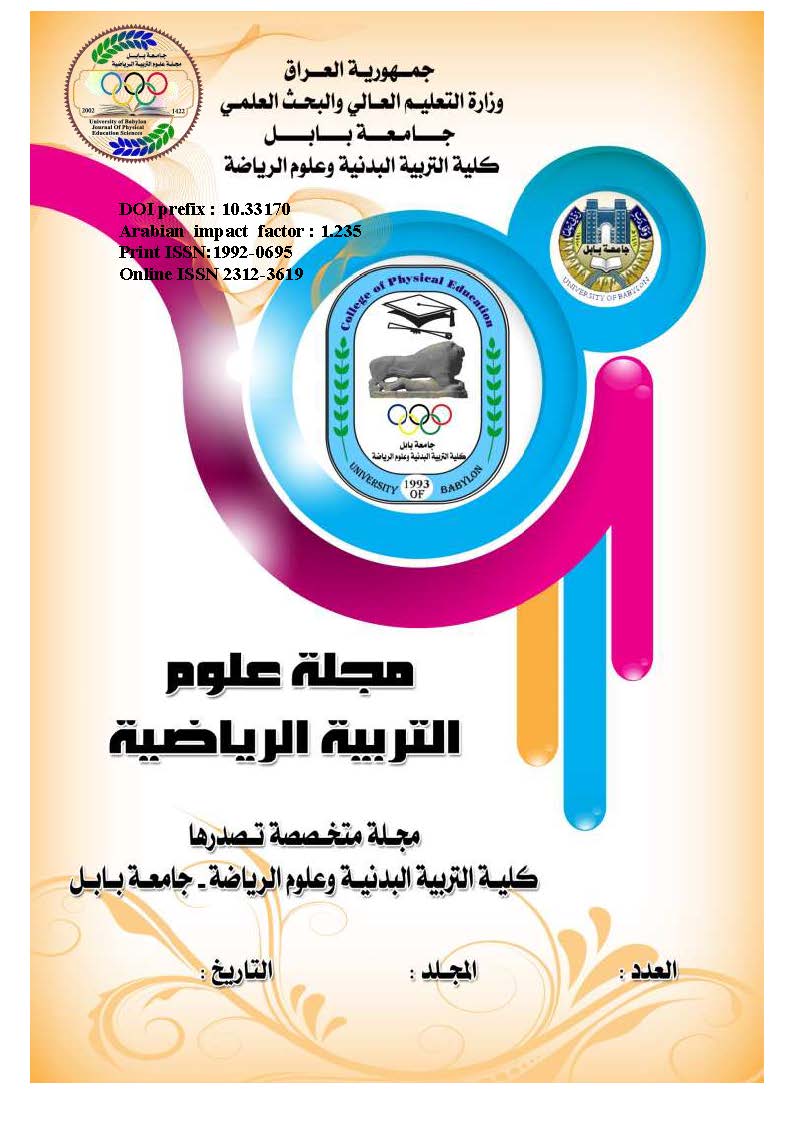Abstract
Abstract:
The study aimed to identify the values of the biomechanical variables of the four stages (approach, rise, hitting, landing) in the skillful performance of the wavy serving skill of jumping by volleyball.
The researchers used the descriptive approach in the method of associative relations which is appropriate to the nature of the research problem. The researchers identified the research community and they are players of Al-Rumaitha sports club volleyball team (10) players were given to each player three attempts, to have (30) views are subjected to analysis and the best score was chosen. The test was shown to a group of experts. As for the biomechanical variables, the researchers used a camera type (CASIO) with a frequency speed of 300 images / s to extract the biomechanical variables. The researchers used kinovea (0.8.24) kinetic analysis program to extract the values of the biomechanical variables. The most important conclusions are that the distance of the implementation of the transmission in the first stage until the stage of ascension greatly affect the degree of perfect angles of the joints that allow to take the good technical situation, the more appropriate angles whenever the shape of motor in the best case. , And the increase in the degree of knee joint leads to increase the starting angle and maximum flexion of the trunk arc and the height of the hip point at the moment of hitting the ball.
The study aimed to identify the values of the biomechanical variables of the four stages (approach, rise, hitting, landing) in the skillful performance of the wavy serving skill of jumping by volleyball.
The researchers used the descriptive approach in the method of associative relations which is appropriate to the nature of the research problem. The researchers identified the research community and they are players of Al-Rumaitha sports club volleyball team (10) players were given to each player three attempts, to have (30) views are subjected to analysis and the best score was chosen. The test was shown to a group of experts. As for the biomechanical variables, the researchers used a camera type (CASIO) with a frequency speed of 300 images / s to extract the biomechanical variables. The researchers used kinovea (0.8.24) kinetic analysis program to extract the values of the biomechanical variables. The most important conclusions are that the distance of the implementation of the transmission in the first stage until the stage of ascension greatly affect the degree of perfect angles of the joints that allow to take the good technical situation, the more appropriate angles whenever the shape of motor in the best case. , And the increase in the degree of knee joint leads to increase the starting angle and maximum flexion of the trunk arc and the height of the hip point at the moment of hitting the ball.
Abstract
هدفت الدراسة الى التعرف على قيم المتغيرات البيوميكانيكية للمراحل الاربعة (الاقتراب، الارتقاء، الضرب، الهبوط) في الاداء المهاري للإرسال المتموج بالقفز بالكرة الطائرة.
استعمل الباحث المنهج الوصفي بأسلوب العلاقات الارتباطية وهو ما يتلاءم وطبيعة مشكلة البحث. وقد حدد الباحثون مجتمع البحث وهم لاعبي نادي الرميثة الرياضي بالكرة الطائرة وعددهم (10) لاعبين أعطيت لكل لاعب ثلاث محاولات، ليكون لدينا (30) مشاهدة تخضع جميعها للتحليل.
تم اجراء اختبار الاداء المهاري للإرسال المتموج من القفز لعينة البحث واعطي لكل لاعب ثلاث محاولات موزعة على اقسام المهارة ويتم اختيار أفضل درجة من كل مقوم وتم عرض الاختبار على مجموعة من الخبراء وعددهم ثلاثة واستبعدت اعلا درجة واقل درجة اما الباقين تم استخراج الوسط الحسابي لهم. اما بخصوص المتغيرات البايوميكانيكية استخدم الباحثون كامرتي نوع(CASIO) ذات سرعة تردد 300صورة/ثا وذلك لاستخراج المتغيرات البايوميكانيكية واستعان الباحثون (برنامج التحليل الحركي (kinovea .0.8.24) لاستخراج قيم المتغيرات البايوميكانيكية .
اما اهم الاستنتاجات فهي إن المسافة المقطوعة لتنفيذ الارسال في المرحلة الأولى حتى مرحلة الارتقاء توثر بشكل كبير في درجة مثالية زوايا المفاصل التي تسمح لاتخاذ الوضع الفني الجيد، فكلما كانت الزوايا مناسبة كلما كان الشكل الحركي في أفضل حال. وإن الزيادة بدرجة مفصل الركبة يؤدي إلى زيادة زاوية الانطلاق وأقصى انثناء لقوس الجذع وارتفاع نقطة الورك لحظة ضرب الكرة، إذ إن تلك الزيادة تسهم برفع قيمة المتغيرات التي تؤثر بشكل مباشر في خدمت الواجب الحركي.
استعمل الباحث المنهج الوصفي بأسلوب العلاقات الارتباطية وهو ما يتلاءم وطبيعة مشكلة البحث. وقد حدد الباحثون مجتمع البحث وهم لاعبي نادي الرميثة الرياضي بالكرة الطائرة وعددهم (10) لاعبين أعطيت لكل لاعب ثلاث محاولات، ليكون لدينا (30) مشاهدة تخضع جميعها للتحليل.
تم اجراء اختبار الاداء المهاري للإرسال المتموج من القفز لعينة البحث واعطي لكل لاعب ثلاث محاولات موزعة على اقسام المهارة ويتم اختيار أفضل درجة من كل مقوم وتم عرض الاختبار على مجموعة من الخبراء وعددهم ثلاثة واستبعدت اعلا درجة واقل درجة اما الباقين تم استخراج الوسط الحسابي لهم. اما بخصوص المتغيرات البايوميكانيكية استخدم الباحثون كامرتي نوع(CASIO) ذات سرعة تردد 300صورة/ثا وذلك لاستخراج المتغيرات البايوميكانيكية واستعان الباحثون (برنامج التحليل الحركي (kinovea .0.8.24) لاستخراج قيم المتغيرات البايوميكانيكية .
اما اهم الاستنتاجات فهي إن المسافة المقطوعة لتنفيذ الارسال في المرحلة الأولى حتى مرحلة الارتقاء توثر بشكل كبير في درجة مثالية زوايا المفاصل التي تسمح لاتخاذ الوضع الفني الجيد، فكلما كانت الزوايا مناسبة كلما كان الشكل الحركي في أفضل حال. وإن الزيادة بدرجة مفصل الركبة يؤدي إلى زيادة زاوية الانطلاق وأقصى انثناء لقوس الجذع وارتفاع نقطة الورك لحظة ضرب الكرة، إذ إن تلك الزيادة تسهم برفع قيمة المتغيرات التي تؤثر بشكل مباشر في خدمت الواجب الحركي.
Keywords
علاقة، المتغيرات البيوميكانيكية، الأداء الحركي، مهارة الارسال المتموج، بالكرة الطائرة
